لكل صناعة لغتها الخاصة بها.
قد تبدو هذه المصطلحات التقنية والمختصرات والعبارات الخاصة بالمجال، بالنسبة للأذنين والعيون غير المدربة، وكأنها لغة أجنبية. وعندما تكون محترفًا في مجال عملك، فإن فهم هذه المصطلحات الرئيسية أمر بالغ الأهمية لأنها يمكن أن تؤثر على طريقة تواصلك مع الآخرين ونجاح مشروعك.
لذلك عندما تدير مشروعًا إنشائيًا، من الضروري التواصل مع المصطلحات الصحيحة لضمان أن يكون الجميع على نفس الصفحة ويفهمون بوضوح أهداف المشروع الإجمالية. إذا لم تكن حذرًا، فقد يكون مصطلح واحد أسيء استخدامه كافيًا للتأثير سلبًا على مشروعك أو جرفه إلى الأرض.
لذا دعنا نتجنب ذلك! فيما يلي مسرد مفيد يحتوي على 50 مصطلحاً من المصطلحات الأكثر استخداماً التي يجب على كل مدير بناء ومدير مشروع ومحترف في صناعة البناء والتشييد أن يحفظها عن ظهر قلب. لقد قمنا أيضًا بتضمين بعض القوالب المتعلقة بإدارة المشروع لإضافة المزيد من الأدوات المفيدة إلى حزام أدوات مدير المشروع.
50 مصطلحات إدارة الإنشاءات التي يجب معرفتها
أ-ك: إدارة المشاريع الرشيقة لبدء الاجتماع
1. إدارة المشاريع الرشيقة

الإدارة الرشيقة للمشروع مكرسة للتكيف مع الوضع أثناء تطوره. يمكن لمديري الإنشاءات تحقيق الإدارة الرشيقة من خلال مراقبة المشروع عن كثب وإجراء التغييرات أو القرارات حسب الحاجة.
يتيح البرنامج الجيد لإدارة المشاريع الرشيقة إمكانية إدارة سير العمل في سباقات السرعة بسهولة، وتولي المهام وإنجازها بسرعة، وتزويد فريق مشروعك بالمرونة والهيكلية والدعم الذي يحتاجونه للمضي قدماً في المشاريع.
مكافأة: برنامج إدارة علاقات العملاء للإنشاءات
2. السعر الشامل
يلخص المعدل الإجمالي التكلفة الإجمالية لمشروع أو عنصر بناء معين، بما في ذلك التكاليف المباشرة وغير المباشرة. على سبيل المثال، قد يشمل ذلك الشحن وساعات العمل ولوازم التركيب.
3. مهندس السجل
المهندس المعماري المسجل هو الشخص الذي يظهر اسمه على تصاريح البناء ويشرف على سلامة وإنجاز مشروع البناء. قد لا يكون هذا الشخص هو المصمم، بل هو مدير موقع معماري مرخص له متاح للتعامل مع الأعمال الورقية للمشروع.
تحقق من أدوات إدارة المشاريع هذه للمهندسين المعماريين
4. فاتورة الكميات (BOQ)
يستخدم BOQ أو فاتورة الكميات للمساعدة في تسعير المشروع. وهو عبارة عن قائمة مفصلة بجميع الأعمال والمواد اللازمة لإكمال مشروع البناء كما هو مخطط له.
5. الحجب

يشير الحظر إلى المهام التي لا يمكن العمل عليها أو المهام التي يتم "منعها" ببساطة من بدء شخص ما العمل حتى تكتمل مهمة أو مهمة فرعية سابقة. هذا يمنع سير العمل المعطل عندما يتم تعيين التبعيات لمنع شخص ما من المضي قدمًا في المشروع.
على سبيل المثال، في مشروع إعادة تشكيل المطبخ، على سبيل المثال، في مشروع إعادة تشكيل المطبخ، سيتم تعيين تبعية تمنع تركيب الخزائن لمهمة العرض التوضيحي، بحيث لا يمكن تركيب الخزائن الجديدة حتى يكتمل عرض المطبخ.
6. عنق الزجاجة
عنق الزجاجة هو نقطة ازدحام في المشروع، حيث يجب إكمال عنصر ما أو تصفيته قبل أن يمكن مواصلة العمل الآخر.
على سبيل المثال، يمكن أن يصبح كل من وجود معدات ذات حجم خاطئ، أو انتظار تسليم المواد، أو خطوة تركيب ضرورية عنق الزجاجة.
7. التعاون
يحدث التعاون عندما تعمل فرق متعددة من المقاولين أو المتخصصين معًا. يجب أن يتم التعاون في البناء بالترتيب الصحيح حتى يتم الانتهاء من أشياء مثل تركيبات الجدران الخلفية والجدران الجافة بكفاءة.
8. برنامج إدارة الإنشاءات
تمكّن برامج إدارة الإنشاءات مديري الإنشاءات من تحسين كفاءة المشروع وجدولة الإنشاءات والإشراف عليها وإسناد المهام. يجب أن يتضمن ميزات مثل مخططات التصميم بمساعدة الحاسوب، والتوثيق، ومخططات جانت، ولوحات التحكم، وتتبع الوقت عبر الهاتف المحمول، والقوالب، والمزيد لمساعدتك في إدارة مشروعك داخل وخارج الموقع.
استخدم نموذج تقرير ClockConstruction اليومي لتتبع تقدمك اليومي لسهولة التنظيم والتخطيط.
9. طريقة المسار الحرج (CPM)
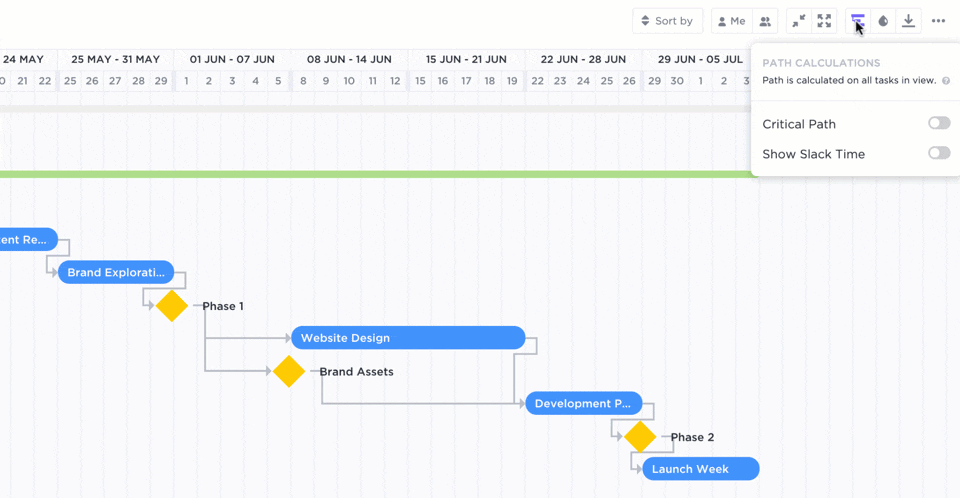
طريقة المسار الحرج (CPM) في البناء هي طريقة جدولة المشروع. يمكن للمديرين استخدام برنامج لتقسيم الأنشطة المطلوبة في مشاريع البناء بناءً على المدة الزمنية التي ستستغرقها وترتيب إنجاز هذه المهام.
10. التبعيات

التبعيات هي المهام التي يجب إكمالها قبل أن تبدأ مهمة أخرى. على سبيل المثال، تعتمد الأسلاك خلف الجدار على تركيب تركيب تركيبات الإضاءة لأن تركيبات الإضاءة تعتمد على اكتمال الأسلاك.
11. التصميم والبناء
يمثل التصميم والبناء مفهوم التعاقد مع نفس الفريق لتصميم وبناء المشروع. ويضمن ذلك وجود المصممين ضمن فريق العمل للحفاظ على توافق المشروع مع التصميم وأن يتم الانتهاء من التصميمات مع مراعاة قدرات البنائين. يمكن لخدمات التصميم والبناء أن تخفض التكاليف وتحسّن المنجزات بسبب تقليل توزيع المسؤولية.
12. أمر العمل الميداني
أمر العمل الميداني هو مستند يسرد المهام الموكلة لمقاول من الباطن مع الإشارة إلى التوجيهات لإتمام العمل. يتم إعطاء هذا الأمر من قبل المقاول العام إلى المقاول من الباطن، ويقتصر النطاق فقط على ما يحتاج المقاول من الباطن إلى معرفته والقيام به.
13. المتابعة
المتابعة هي ممارسة التحقق مرة أخرى من المشروع للتأكد من أن العمل مُرضٍ. يمكن القيام بذلك في كل مستوى من مستويات البناء، والتأكد من اكتمال كل مهمة وجاهزيتها للمرحلة التالية. كما يقوم بها المقاولون مع العملاء للتأكد من أن المنتج النهائي يرضيهم.
14. سجل الإصدار
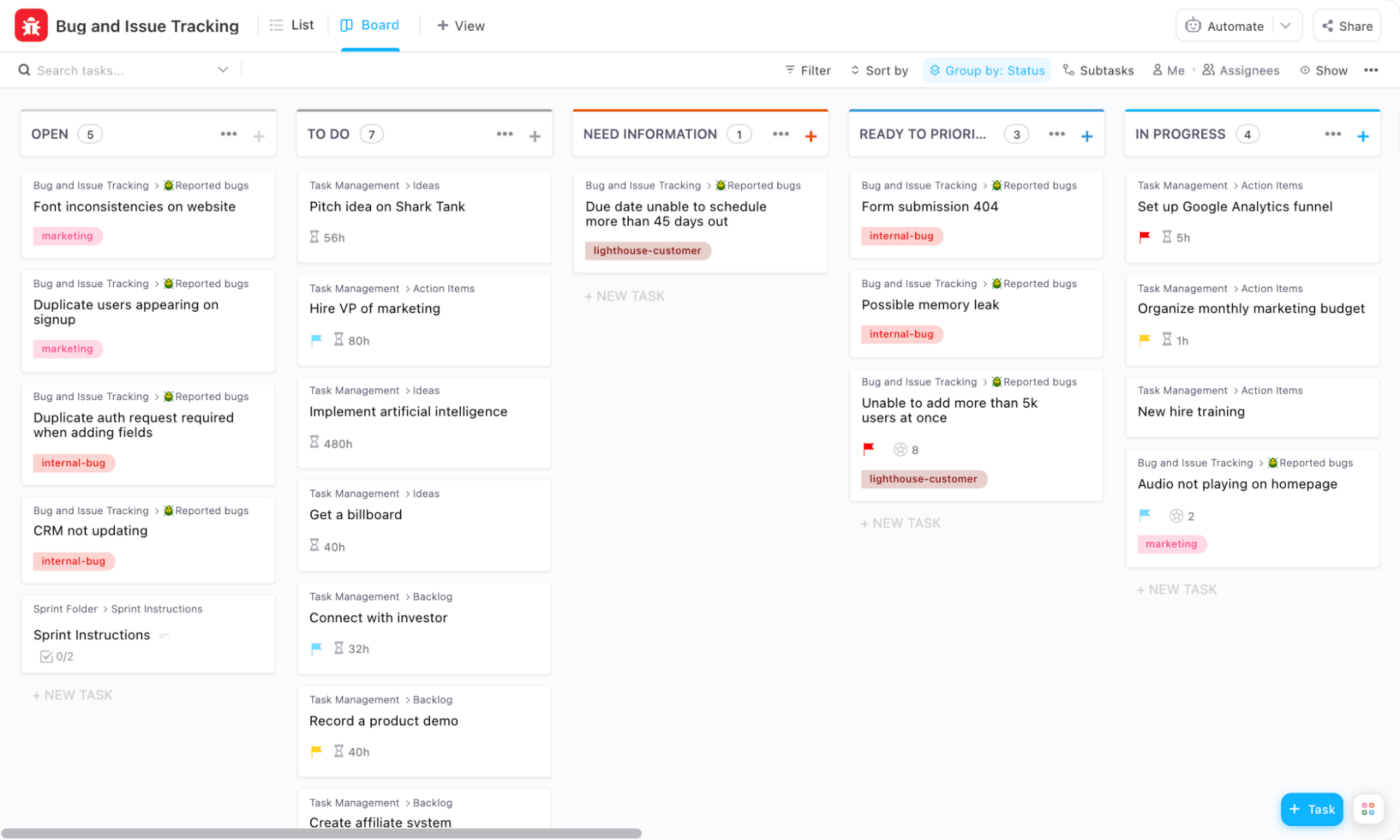
سجل المشكلات هو مستند يتم فيه تسجيل وتتبع جميع المشكلات التي تؤثر سلبًا على المشروع. ويشمل ذلك المشكلات التي تم حلها بالفعل والمشكلات التي تسببت في تأخيرات أو مشاكل مستمرة.
15. إدارة الإصدار
إدارة المشكلات هي عملية معالجة وحل المشكلات التي يتم إدخالها في السجلات. يتم تحديد أولويات التأخيرات المعروفة والعوامل السلبية الأخرى في المشروع لإيجاد طرق للتغلب على المشكلة أو العمل على حلها.
16. تتبع الإصدار
تتبع المشكلة هو ممارسة البقاء على رأس مشكلة مستمرة. قد يتتبع المقاول شحنة متأخرة، على سبيل المثال. وعادةً ما يتم ذلك باستخدام برنامج تتبع المشكلات الذي يسمح للمقاول العام بتعيين المسؤولية والتحقق من المشكلات المعروفة على لوحة التحكم.
استخدم قالب تتبع الأخطاء والمشكلات في ClickUp للإبلاغ عن الأخطاء وتتبعها وتحديد أولوياتها في نفس المكان الذي تقوم فيه ببقية أعمالك
17. أنواع المشكلات
كل مشكلة لها نوع. تشمل أنواع المشكلات في البناء التأخيرات في الشحن، ولوائح الامتثال، والبقاء في الموعد المحدد، ومخاوف جودة المواد، وأنواع أخرى من المشكلات التي يمكن أن تنشأ قبل وأثناء مشروع البناء.
مكافأة: برنامج إدارة المقاول!
18. اجتماع الانطلاق
الاجتماع الافتتاحي هو أول اجتماع رئيسي بين جميع المشاركين في مشروع البناء. يتأكد المقاول العام من أن الجميع يفهمون مهام وأهداف فريقهم، ويتم وضع الجدول الزمني للبناء، وتعيين كل فريق أو متخصص في الجدول الزمني بناءً على الترتيب الذي سيتم به البناء.
استخدم قالب اجتماع بدء المشروع من ClickUp لبدء مشروعك القادم بشكل صحيح.
*تحقق من نماذج التقارير اليومية هذه!
M-W: جدول أعمال الاجتماع إلى نموذج الشلال
19. جدول أعمال الاجتماع
جدول أعمال الاجتماع هو قائمة بالمواضيع التي يجب تغطيتها خلال الاجتماع. في أي وقت يتم فيه عقد اجتماع بناء، يمكن استخدام جدول أعمال للمساعدة في إبقاء المحادثة على المسار الصحيح وتغطية جميع الموضوعات الضرورية. ويشمل ذلك معالجة الجدول الزمني والمشاكل المعروفة وتنسيق المقاولين من الباطن.
استخدم قالب الاجتماعات في ClickUp لإنشاء جدول أعمال اجتماعك المثالي والحفاظ على سير العملية باستمرار إلى الأمام.
20. محضر الاجتماع
عند عقد اجتماع، يمكن تدوين محضر الاجتماع. محضر الاجتماع هو سجل لجميع الموضوعات التي تمت تغطيتها في الاجتماع والوقت التقريبي الذي تمت فيه تغطية هذه البنود. يمكن أن تكون محاضر الاجتماعات مفصلة أو عامة، ولكن أفضل طريقة لتدوين المحاضر هي من خلال أداة برمجية تضيف طوابع زمنية وتتضمن اختصارات لتدوين ملاحظات سريعة وواضحة.
قم بتبسيط عملية تدوين الملاحظات وتسجيل ملاحظات الاجتماع بشكل أفضل باستخدام قالب محضر الاجتماع من ClickUp.
21. المعالم الرئيسية
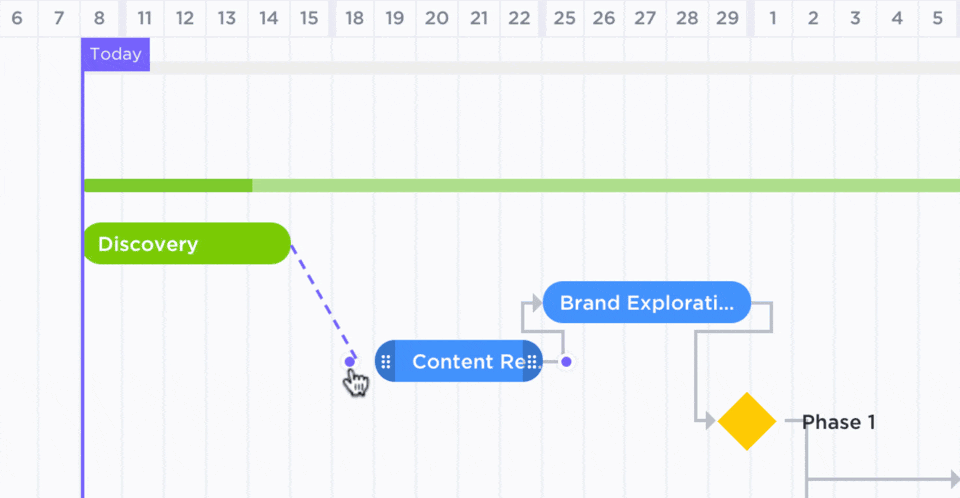
المعلم هو حدث رئيسي في مشروع البناء. ويعني هذا عادةً أن مرحلة كبيرة من البناء قد اكتملت أو أن المشروع قد وصل إلى نقطة يمكن للعميل أن يتجول في موقع العمل لرؤية التقدم المحرز. على سبيل المثال، يمكن اعتبار اكتمال التأطير، على سبيل المثال، معلماً إنشائياً.
22. ميزانية المشروع

ميزانية المشروع هي قائمة مفصلة معتمدة رسميًا لجميع التكاليف والمصروفات المتوقعة لإكمال مشروع إنشائي.
23. مدير المشروع
مدير المشروع في مجال الإنشاءات هو المسؤول عن تنسيق جميع عناصر ومهام البناء وإبقاء مختلف الفرق والمتخصصين على المسار الصحيح. كما أنه مسؤول عن وضع الجدول الزمني للمشروع، وتحديد مؤشرات الأداء الرئيسية للمشروع، واختيار طريقة التسليم المناسبة للمشروع، وإدارة تكاليف المشروع، ومراقبة أداء المشروع والإبلاغ عنه، والتأكد من استيفاء جميع مخرجات المشروع.
24. خطة المشروع

تحدد خطة مشروع البناء، التي يضعها مدير المشروع، أهداف المشروع وغاياته ومهامه ومراحله الرئيسية ونواتجه وموارده بالتفصيل. من المهم وضع خطة المشروع التي تحدد الطرق الأكثر كفاءة وفعالية من حيث التكلفة لإكمال مشروع البناء بما يتماشى مع جميع المتطلبات وبما يرضي العميل.
من الطرق الفعّالة لتصور خطتك وجعلها سهلة الوصول لفريق مشروعك أو أصحاب المصلحة هي إنشاء قائمة بالمهام في منصة إدارة المشاريع، مثل ClickUp، وإنشاء حالات مخصصة لتحديد مراحل مشروعك بوضوح وإضافة حقول مخصصة لعرض جميع تفاصيل المشروع الرئيسية في عرض واحد.
25. إدارة محفظة المشروع (PPM)
في مجال الإنشاءات، إدارة محفظة المشاريع (PPM) هي النهج الاستراتيجي الذي يتيح لشركات الإنشاءات تحليل وتحسين أدائها وعائد الاستثمار والموارد والعمليات. يقوم المقاولون بتحليل المحفظة من أجل تحسين التكاليف والموارد والتقنيات المستخدمة في جميع المشاريع ضمن المحفظة، مما يسمح بإجراء تحسينات وكفاءة في التكلفة عبر مشاريع متعددة بدلاً من مشروع واحد في كل مرة.
26. أصحاب المصلحة في المشروع
يشمل أصحاب المصلحة في مشروع البناء أي شخص مشارك في المشروع وقد يؤثر على نتائج المشروع. وهذا يشمل العميل ومالك العقار والمقاول العام والمقاولين من الباطن وفريق المشروع والموردين وحتى السلطات الحكومية مثل المجالس المحلية.
27. الجدول الزمني للمشروع
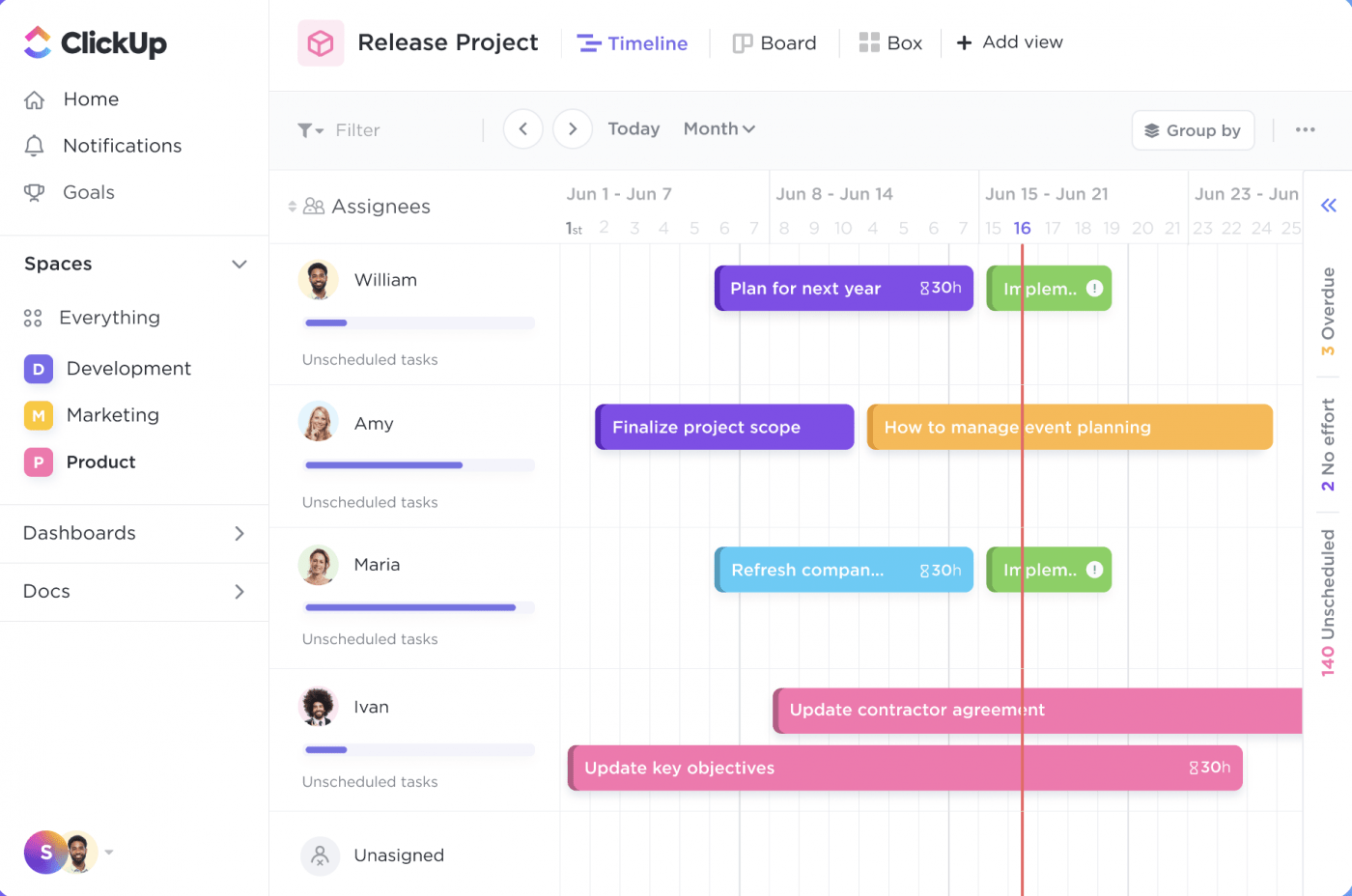
يتم وضع الجدول الزمني للمشروع في مرحلة التخطيط لدورة حياة المشروع. وهو يحدد بوضوح الجدول الزمني للإنشاءات ومدة المشروع والوقت الذي ستستغرقه كل مرحلة من مراحل المشروع الإنشائي.
لضمان أن يتمكن فريق المشروع من تصور الجدول الزمني للمشروع ومتابعته بشكل صحيح، يجب على مديري المشاريع الاستثمار في أداة إدارة مشاريع البناء التي تسمح لهم بإنشاء عرض واضح للجدول الزمني. استخدم قالب الجدول الزمني لـ ClickUp لمراقبة الجدول الزمني لمشروعك القادم.
28. قائمة الكميات
قائمة التثقيب في البناء هي مستند يسرد كل ما لم يكتمل بعد أو لا يفي بمواصفات العميل. وعادةً ما يتم تقديم قائمة التثقيب في نهاية المشروع كجزء من وثائق المقاول لإغلاق المشروع واستلام المدفوعات.
29. ضمان الجودة
ضمان الجودة هي خطة منهجية يتم تنفيذها لتتبع وضمان اكتمال المشروع وفقًا لمعايير جودة معينة. يتم تنفيذ ضمان الجودة بانتظام خلال المشروع ومع اكتمال كل مرحلة من مراحل المشروع.
30. مراقبة الجودة
مراقبة الجودة هي عملية يتم من خلالها تقييم المواد والأعمال المنجزة للتأكد من أن كل شيء مطابق لمعايير الجودة المحددة. يتم تطبيق مراقبة الجودة عند اكتمال كل مهمة ومشروع لتحديد ما إذا كانت هناك حاجة لإجراء تغييرات في عملية ضمان الجودة.
31. خطة إدارة الجودة
خطة إدارة الجودة هي عبارة عن مخطط تفصيلي لمعايير الجودة لأصحاب المصلحة، وعملية ضمان الجودة، وسياسات مراقبة الجودة التي سيتم استخدامها لإكمال المشروع. وعادةً ما تكون خطة إدارة الجودة جزءًا من خطة إدارة المشروع الكلية.
32. تخطيط الجودة
يحدد تخطيط الجودة، الذي يتم إنجازه من قبل مدير المشروع، معايير الجودة المتوقعة التي سيتم الالتزام بها خلال مشروع البناء. ويتضمن وضع خطة اتصالات الجودة، وعملية لتأهيل المقاولين، ومخطط تفصيلي لخطة مراقبة ضمان الجودة، وإجراءات مراقبة الجودة، وتحديد إجراءات عدم المطابقة.
33. تخصيص الموارد
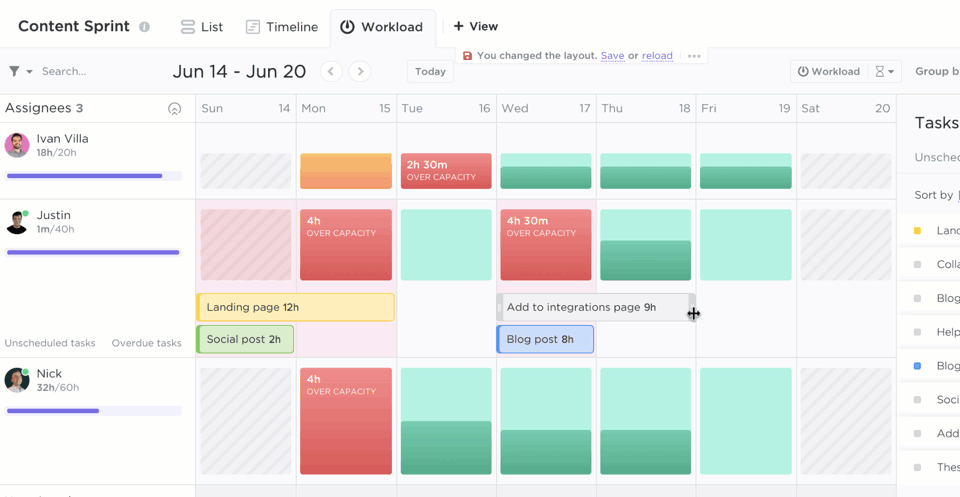
يحلل تخصيص الموارد الطريقة الأكثر فعالية لتخصيص الموارد للفرق والمهام أثناء مشروع البناء. يؤدي ذلك إلى زيادة الموارد إلى أقصى حد لتلبية أهداف البناء والمشروع على أفضل وجه.
34. توافر الموارد
يتم تحديد مدى توافر الموارد من خلال تقييم الموارد المتاحة أو التي يمكن الحصول عليها في الوقت المحدد لإنجاز المشروع الإنشائي.
35. هيكل تقسيم الموارد
هيكل توزيع الموارد هو قائمة شاملة لجميع الموارد التي ستكون مطلوبة لإكمال عملية البناء. قد يشمل ذلك الموارد التي يمكن لمقاول البناء الوصول إليها والعناصر التي ستحتاج إلى طلبها.
36. تقويم الموارد

يحدد تقويم الموارد لمشروع إنشائي متى ستكون الموارد متاحة. قد يشمل ذلك، على سبيل المثال، جداول تسليم المواد التي ستصل عندما يكون المشروع قيد التنفيذ بالفعل.
أبقِ فريق المشروع ومدير الإنشاءات ومدير المشروع وجميع أصحاب المصلحة الرئيسيين الآخرين على اطلاع دائم في جميع الأوقات من خلال إنشاء تقويم رقمي للموارد يحدد أنشطة مشروعك ومهام المشروع المهمة في عرض تقويم سهل المتابعة.
37. تسوية الموارد
تحدث عملية تسوية الموارد عندما يقوم المقاولون بتعديل الجدول الزمني للمشروع لإبقاء استخدام موارد معينة دون حد معين. على سبيل المثال، يضمن ذلك عدم عمل المقاولين من الباطن لوقت إضافي أو عدم الإفراط في استخدام سعة المولد.
مكافأة: برنامج الذكاء الاصطناعي للإنشاءات!
38. إدارة المخاطر
إدارة المخاطر هي عملية تحديد جميع المخاطر التي يمكن أن تحدث في المشروع وتقييم احتمالية تسببها في التأخير والمشاكل الأخرى، وتوفر نظرة عامة حول كيفية منع المخاطر من التأثير على أهداف المشروع. تتراوح مخاطر البناء من مخاطر السلامة إلى تأخيرات الموردين.
استخدم نماذج إدارة المخاطر هذه!
39. تخفيف المخاطر
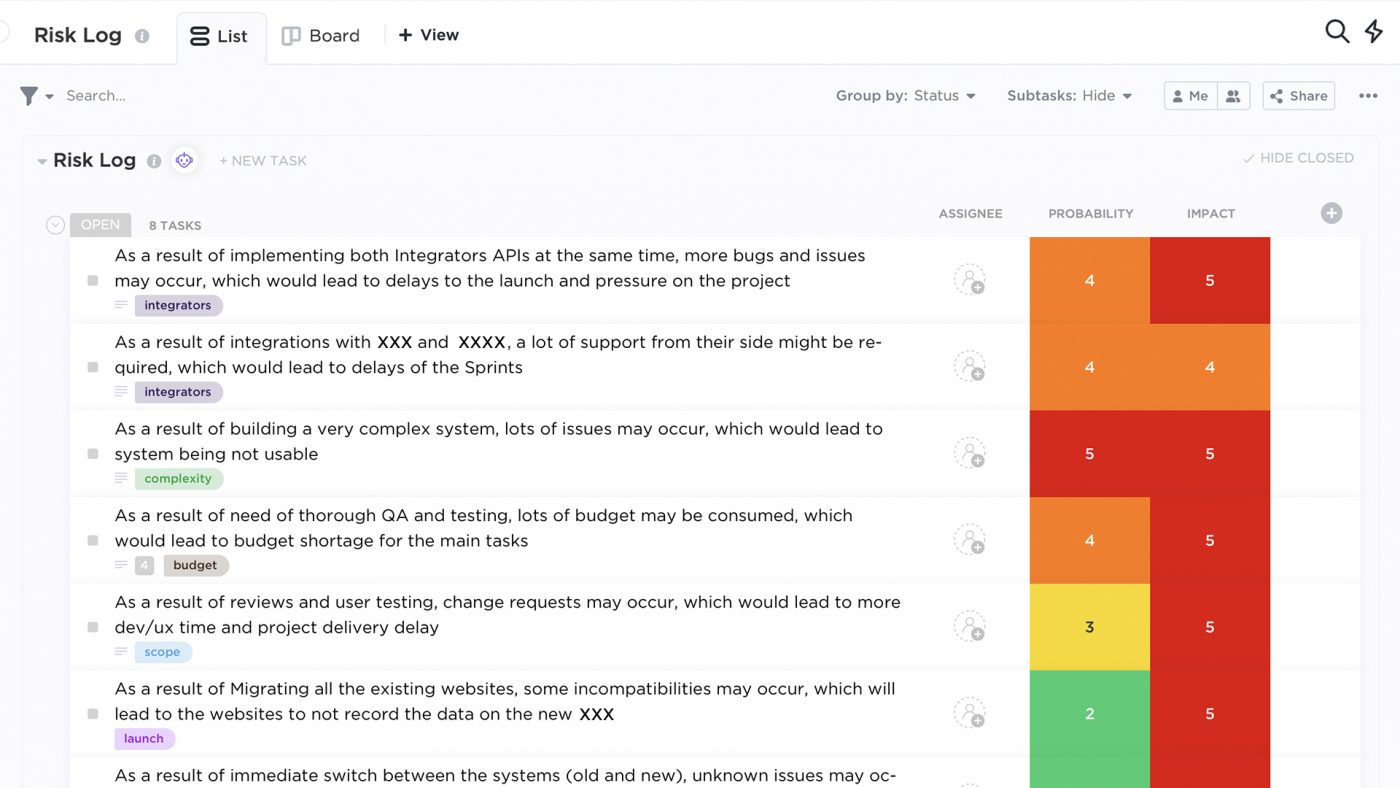
تم تصميم استراتيجية التخفيف من المخاطر لكل خطر محدد وتحدد خطة للحد من المخاطر المعروفة أو تقليلها أو العمل على تجنب الآثار السلبية أو تحول الخطر إلى خطر فعلي.
حافظ على سجل مخاطر مشروعك منظمًا ومرئيًا وقابلًا للتتبع من خلال إنشاء قائمة في ClickUp، وإضافة حقول مخصصة لتوضيح كل خطر وتأثيره بوضوح، وإنشاء علامات مخصصة لإضافة المزيد من السياق وتصنيف كل خطر.
40. مراقبة المخاطر والتحكم فيها
مراقبة المخاطر والتحكم فيها هي عملية تتبع المخاطر المعروفة وتنفيذ خطط الاستجابة وتحديد المخاطر الجديدة الواردة والاستجابة لها لتحسين عملية إدارة المخاطر.
41. مالك المخاطر
مالك المخاطر مسؤول عن تتبع وإدارة مخاطر معينة. وقد يكون مسؤولاً أيضاً عن التحليل المستمر للمخاطر.
42. جدول القيم

جدول القيم هو قائمة بمهام العمل أو العناصر المدرجة مع القيمة المقابلة لها. يجب أن يمثل الجدول الإجمالي للقيم التكلفة الكاملة لمشروع البناء. ويستخدمها المقاولون للمساعدة في معالجة طلبات الدفع.
قم بإنشاء جدول زمني مفصل بالقيم عن طريق إضافة حقل مخصص للنقود في ClickUp إلى طريقة عرض القائمة لإظهار ميزانيات المنتجات لكل مهمة أو مشروع.
43. سكروم
Scrum هو إطار عمل لإدارة المشاريع يركز على التعاون المستمر والدوري بين أعضاء الفريق طوال دورة حياة المشروع. في مجال البناء، قد يمثل سكروم اجتماعات منتظمة لجدولة كل مرحلة من مراحل مشروع البناء ثم تفعيلها.
44. المواصفات
مواصفات البناء، أو المواصفات، هي تفاصيل حول المواد المستخدمة أو العمل المطلوب لإكمال كل مرحلة من مراحل المشروع. قد تتضمن مواصفات سطح السفينة الوزن الذي يمكن أن يحمله أو حجم الألواح المستخدمة. مواصفات اللوح هي أبعاد الحجم وقوة الشد.
45. سبرينت

في إدارة المشاريع الرشيقة، يتم تقسيم المشاريع إلى مراحل قصيرة قابلة للتكرار تسمى سباقات السرعة التي عادةً ما تسمح عادةً بإكمال أسبوع إلى شهر، بحيث يعمل جميع أعضاء فريق المشروع المشاركين في سباق السرعة بسرعة للوفاء بالجدول الزمني. غالبًا ما يحدث البناء في سباقات السرعة، حيث تعمل فرق من المقاولين أو المقاولين من الباطن لإكمال كل مرحلة أو يوم عمل في عدد محدد من الساعات.
قم بتبسيط وتوحيد عمليات فريقك من خلال إنشاء سير عمل منظم وقابل للتكرار ومتسق مع قالب ClickUp's Sprints.
46. اجتماع الاستعداد
الاجتماع التحضيري هو اجتماع قصير وسريع يقدم فيه كل عضو من أعضاء فريق المشروع تحديثًا عن تقدم العمل ومشاركة أي بيانات تنسيق ضرورية. وغالبًا ما تُعقد الاجتماعات التحضيرية في نفس الوقت كل يوم.
47. الوقت والمواد (T&M)
الوقت والمواد (T&M) هي طريقة يتم فيها الدفع للمقاول مقابل التكاليف الفعلية فقط، بما في ذلك ساعات العمل المنجزة والمواد المشتراة.
قم بإدارة أسعار خدماتك ومنتجاتك مباشرةً داخل ClickUp. قالب قائمة الأسعار هذا مفيد للشركات التي تعتمد على المنتجات ومقدمي الخدمات!
48. نموذج الشلال
النموذج الانحداري هو منهجية لإدارة المشاريع ذات التدفق التنازلي التي تتعامل مع مرحلة واحدة في كل مرة دون تداخل المراحل. قد تكون طريقة الشلال مفيدة في البناء بسبب الطبيعة المتسلسلة الضرورية للتركيب.
استخدم نموذج إدارة الانحدار في ClickUp لمساعدتك في إنشاء عملية موحدة لإدارة مشاريعك باستخدام نموذج الانحدار.
49. العمل قيد التنفيذ (WIP)
أي مشروع أو مهمة تم البدء فيها ولكنها لم تكتمل بعد تسمى العمل قيد التنفيذ أو WIP. تشمل الأسباب الجذرية ل WIP بدء الكثير من الأشياء في وقت واحد وتشغيل شلالات صغيرة داخل سباق السرعة.
50. حد العمل الجاري
تحدّ بعض المشاريع من عدد المهام التي يمكن أن تكون في مرحلة معينة في وقت واحد أو مقدار العمل الذي قد يكون قيد التنفيذ في وقت واحد. ويُعرف ذلك بحد العمل الجاري. يمكن أن يساعد الحد من العمل الجاري في تحديد الاختناقات والحفاظ على تركيز الفرق.
يمكن لمديري المشاريع الاستفادة من تطبيق WIP Limit Click Up في ClickUp لحماية سعة فريق المشروع من خلال الإشارة بصريًا إلى ما إذا كانت سعة المشروع أقل من السعة أو قريبة منها أو عندها أو فوقها في عرض لوحة ClickUp.
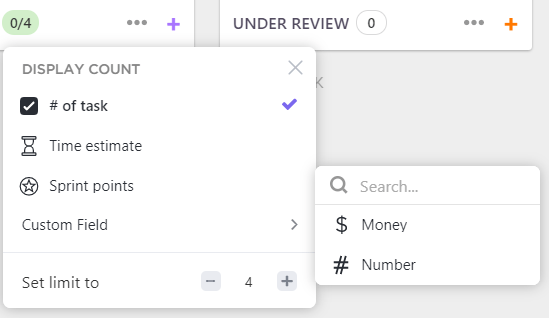
ذات صلة: أسئلة المقابلة الشخصية لمدير مشروع الإنشاءات
املأ مجموعة أدواتك بمصطلحات إدارة الإنشاءات
تتطلب إدارة مشروع إنشائي الكثير من التخطيط والتنسيق والتواصل مع مدير الإنشاءات وفريق المشروع وأصحاب المصلحة الرئيسيين والعملاء. من الضروري معرفة كيفية استخدام مصطلحات إدارة المشروع ومصطلحات البناء بشكل صحيح لضمان نقل المعلومات اللازمة لتلبية التوقعات والبقاء ضمن نطاق المشروع.
بصفتك مديراً للمشروع، فأنت مسؤول أيضاً عن إدارة المخاطر، وتحريك المشروع بسلاسة خلال دورة حياة المشروع، والتحكم في ميزانية المشروع، وتتبع تقدم المشروع - والقائمة تطول. هذا هو المكان الذي تكون فيه أداة إدارة المشروع، مثل ClickUp، مفيدة.
نظرًا لأنه قابل للتخصيص بالكامل، يمكن للفرق بناء سير العمل الأكثر مثالية وفعالية الذي يدعم احتياجات المشروع الفريدة وتفضيلات سير العمل الخاصة بهم. اختر من بين مئات الميزات لتحسين عملية إدارة مشروعك وتعاون فريقك، ودمج أدوات العمل الأخرى لدمج جميع أعمالك في مكان واحد، واستخدام مجموعة واسعة من قوالب البناء القابلة للتحرير في ClickUp لمساعدتك في إدارة أي نوع من المشاريع. 👷♀️👌

